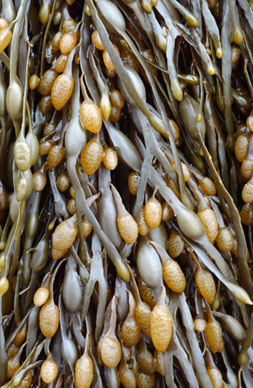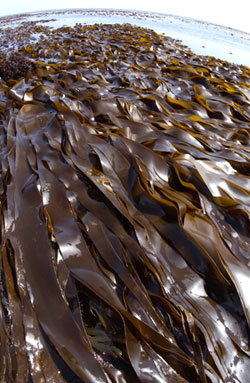Alginate production in Ireland
 The only seaweed collected as an alginate source in Ireland is Ascophyllum nodosum, right). In collaboration with Arramara Teo. (a seaweed company owned by Údarás na Gaeltachta (the Gaetacht Authority) and operating in the Irish-speaking areas of Co. Galway) and with the aid of Marine Institute funding we have carried out an assessment of the Ascophyllum resource using new technology. Instead of assessing
the weed on a weight-per-unit-area basis, we have opted to use local seaweed
buyers to assess the production that an area can support. Using hand-held
GPS (global positioning satellite) devices and Arc-Info, a software package
to assist in mapping--and in collaboration with the Department of Geography
& Coastal Resources Centre, University College, Cork--we have mapped
the Ascophyllum resources of the west coast, and these
data are freely available to any organisation that wishes to avail of
these resources. We have established that at least 130,000 wet t of harvestable Ascophyllum are available annually on the west coat of Ireland, about
34,000 wet t of which are being utilised at present. The main use for this
material will be as seaweed meal for alginate production, at least for the
present. Ascophyllum is generally cut on a four-year cycle with enough
material--usually a stump 25 cm long--left behind after cutting to assist
in regrowth (Baardseth 1955).
The only seaweed collected as an alginate source in Ireland is Ascophyllum nodosum, right). In collaboration with Arramara Teo. (a seaweed company owned by Údarás na Gaeltachta (the Gaetacht Authority) and operating in the Irish-speaking areas of Co. Galway) and with the aid of Marine Institute funding we have carried out an assessment of the Ascophyllum resource using new technology. Instead of assessing
the weed on a weight-per-unit-area basis, we have opted to use local seaweed
buyers to assess the production that an area can support. Using hand-held
GPS (global positioning satellite) devices and Arc-Info, a software package
to assist in mapping--and in collaboration with the Department of Geography
& Coastal Resources Centre, University College, Cork--we have mapped
the Ascophyllum resources of the west coast, and these
data are freely available to any organisation that wishes to avail of
these resources. We have established that at least 130,000 wet t of harvestable Ascophyllum are available annually on the west coat of Ireland, about
34,000 wet t of which are being utilised at present. The main use for this
material will be as seaweed meal for alginate production, at least for the
present. Ascophyllum is generally cut on a four-year cycle with enough
material--usually a stump 25 cm long--left behind after cutting to assist
in regrowth (Baardseth 1955).
A preliminary assessment of the demography of the harvesters of Ascophyllum in the Gaeltacht area of Connemara has been carried out which indicates that the mean age of the harvesters is rather higher than we had appreciated, a cause for considerable concern. Further investigation of this is warranted together with studies of access to the additional resources of Ascophyllum.
 Laminaria digitata (right) and L. hyperborea are of considerable
interest as sources of the commercially important polysaccharide, alginic
acid. About 1,000 dry t of L. hyperborea stipes used to be collected from drift
each year in Ireland, and exported to Scotland for alginate production. This was a very
haphazard business, as for a number of years in the 1980s and early 1990s, perhaps due
to adverse weather conditions, the stipes did not appear at the usual locations
and supplies were very restricted.
Laminaria digitata (right) and L. hyperborea are of considerable
interest as sources of the commercially important polysaccharide, alginic
acid. About 1,000 dry t of L. hyperborea stipes used to be collected from drift
each year in Ireland, and exported to Scotland for alginate production. This was a very
haphazard business, as for a number of years in the 1980s and early 1990s, perhaps due
to adverse weather conditions, the stipes did not appear at the usual locations
and supplies were very restricted.
Although a desk study of the likely extent of the Laminaria hyperborea beds on the west coast has been carried out, and combined with casual observations, further studies are needed to quantify precisely the actual resource and the effects of harvesting. As this kelp has a life-span of at least 4 years, this would require a long-term study.
In Brittany, over 55,000 wet t of Laminaria digitata and 4,000 t of L. hyperborea stipes were harvested annually in the 1990s for alginate production. It is probable that in excess of 100,000 harvestable t L. digitata would be available in Ireland. However, we currently have only the haziest idea of the distribution of the resources of both species. In Norway, 162,000 t of L. hyperborea were harvested in 1994 using special dredges.





